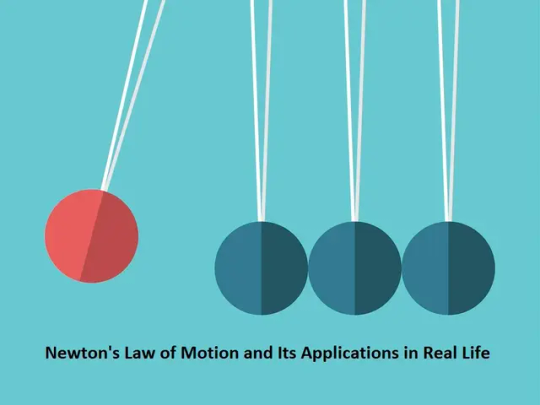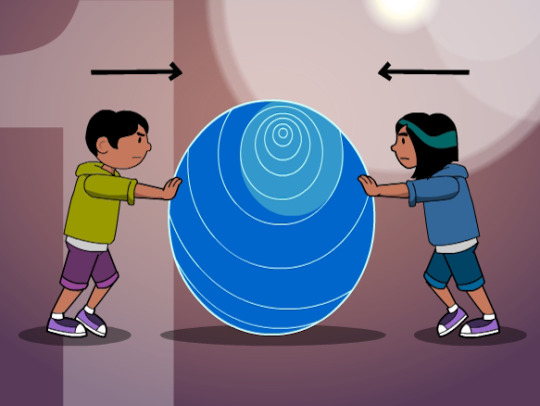Don't wanna be here? Send us removal request.
Text

Easy Learning of Newton’s Laws of Motion – A Must-Watch for Class 11 Students
Newton's Laws of Motion are the foundation of mechanics in Class 11 Physics. Understanding these laws is important for solving motion-related issues in school exams or on entrance tests such as NEET and JEE. These laws are theoretical and commonly used in real-life situations and technical applications.
The blog focuses on fundamental explanations, Laws of Motion examples, and practical solutions to help students grasp how force, motion, and inertia work in combination.
Newton's first law, often known as the Law of Inertia, asserts that an object remains at rest or moves at a constant velocity in a straight path until acted upon by an external force. For example, When your car comes to a sudden stop, your body tends to lean forward, which is known as inertia.
Newton's Second Law defines the relationship between force, mass, and acceleration. Force is defined as the product of mass and acceleration. This implies that heavier objects need more force to accelerate. Pushing a shopping cart is a real-world example. If the cart is empty, it is easy to move; if it is full, it takes much more effort.
Newton's Third Law states that for every action, there is an equal and opposite response. When you jump off a tiny boat onto a dock, the boat moves backward due to the reactive force your legs exert on it.
Students frequently fail to connect principles with applications, such as identifying forces in free-body diagrams or solving numerical problems involving the Laws of Motion. To make this learning process easier and more realistic, we designed a dedicated video lesson that guides students through each law in detail and provides step-by-step solutions.
Watch now on Sethiswiftlearn YouTube Channel:
We thoroughly explained the entire concept using examples, formulas, and problem-solving methodologies. Go through the video, and if you have any questions, leave a comment—we'll help you out.
This is an essential resource for students seeking to improve their intellectual clarity and confidence in Newton's Laws of Motion. Strengthen your understanding and perform better in your Class 11 Physics exams and beyond.
0 notes
Text

Don’t Miss: Class 11 Quadratic Equations Basics – Part 1 Explained Simply
Class 11 Quadratic Equations Basics Part 1, provides a clear and structured explanation of key concepts in Class 11 Math, including the roots of quadratic equation and the quadratic formula. This concept is the foundation for solving real-world mathematics problems and higher-level equations. Part 1 introduces the standard form, discusses the principles behind solving quadratic expressions, and explains the meaning and importance of quadratic equation roots.
Students frequently struggle with quadratic equations, especially when applying the quadratic formula. That's why this video lesson by sethiswiftlearn was created to explain everything in a simple, visual, and user-friendly manner. Whether you're revising or learning the topic for the first time, this content will build your confidence and clarity.
We’ve explained each concept in detail with step-by-step examples on our YouTube channel. Go through the video to strengthen your understanding and perform better in exams.
🎥 Watch now – Class 11th Math - Quadratic Equations | Very Basics - 1 | JEE, CBSE, CUET Brought to you by Sethiswiftlearn, your reliable learning partner for Mathematics concepts.
0 notes
Text

Sets Class 11 Chapter 1 Notes You Can’t Miss: Visual Learning of Representation of Sets
Sets are the first chapter in the Class 11 Maths syllabus, and they serve as the foundation for many higher-level mathematical topics like relations, functions, probability, and more. Sets Class 11 Chapter 1 Notes—covers important topics that will help students rationally categorize and classify objects, making problem solving more efficient. One of the most essential subtopics is Representation of Sets, which introduces students to three major forms: roster form, set-builder form, and Venn diagrams.
These representations are more than simply theoretical; they serve as a foundation for visual thinking and mathematical reasoning. Understanding how sets are formed and represented simplifies many future mathematical subjects. That is why having precise, concise, and visually appealing notes is essential for all Class 11 students.
To make learning even easier, we’ve explained these concepts visually and in detail on our Sethiswiftlearn YouTube channel. The video sessions are intended to lay down the logic behind each sort of representation, accompanied by examples and diagrams. We recommend you to visit our channel to learn about the Representation of Sets, which is described clearly and with step-by-step pictures.
Strengthen your understanding of Class 11 Mathematics Sets and confidently revise Chapter 1 with our simple notes and video strategies. Visual learning not only helps you maintain information more quickly, but it also better prepares you for exams.
0 notes
Text
Sets Class 11 Chapter 1 Notes You Can’t Miss: Visual Learning of Representation of Sets

Sets are the first chapter in the Class 11 Maths syllabus, and they serve as the foundation for many higher-level mathematical topics like relations, functions, probability, and more. Sets Class 11 Chapter 1 Notes—covers important topics that will help students rationally categorize and classify objects, making problem solving more efficient. One of the most essential subtopics is Representation of Sets, which introduces students to three major forms: roster form, set-builder form, and Venn diagrams.
These representations are more than simply theoretical; they serve as a foundation for visual thinking and mathematical reasoning. Understanding how sets are formed and represented simplifies many future mathematical subjects. That is why having precise, concise, and visually appealing notes is essential for all Class 11 students.
To make learning even easier, we’ve explained these concepts visually and in detail on our Sethiswiftlearn YouTube channel. The video sessions are intended to lay down the logic behind each sort of representation, accompanied by examples and diagrams. We recommend you to visit our channel to learn about the Representation of Sets, which is described clearly and with step-by-step pictures.
Strengthen your understanding of Class 11 Mathematics Sets and confidently revise Chapter 1 with our simple notes and video strategies. Visual learning not only helps you maintain information more quickly, but it also better prepares you for exams.
0 notes
Text
Master Class 12 Physics Chapter 2: Electrostatic Potential and Capacitance with Online Video Lessons
Class 12 Physics Chapter 2, which focuses on Electrostatic Potential and Capacitance, is a basic step toward mastering electrostatics. It builds upon the concepts introduced in Electric Charges and Fields and progresses towards understanding electric potential energy, equipotential surfaces, and capacitors in both theory and practical applications. Students who want to improve their academic performance and excel in entrance exams like NEET and JEE must master this chapter.
What makes a difference is not simply reading the textbook, but studying through visual and conceptual clarity. That is why we recommend watching our detailed video lesson on Sethiswiftlearn on YouTube.
We have thoroughly discussed every section of the chapter, from derivations to important formulas, and have enhanced this with real exam-based problems and recommendations. Our Electrostatic Potential and Capacitance Class 12 Notes are summarized to help you retain better and revise faster.
If you're struggling with how potential varies in a field or how capacitance is affected by dielectric materials, our online video lessons will clear your doubts effectively. Go through the complete video, and for any queries, feel free to comment—we’ll respond to guide you further.
Stay ahead with smart learning and make Physics simpler with expert video support.

2 notes
·
View notes